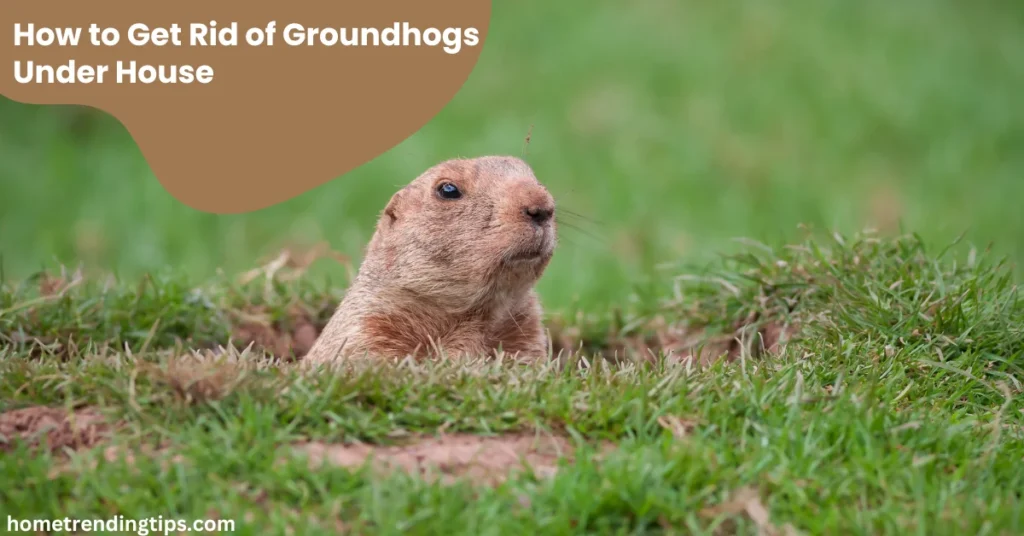Groundhogs—also known as woodchucks or whistle pigs—might seem harmless, but when they burrow beneath your house they can weaken foundations and disrupt gardens, lawns, or sheds. If you’re wondering how to get rid of groundhogs under house without harming the animals or the environment, this detailed guide provides everything you need: step-by-step eviction, natural deterrents, fencing solutions, prevention, FAQs, and expert sources so you can reclaim your property safely and responsibly.
Understanding Groundhog Risks Under Your House
Groundhogs are excellent diggers, creating intricate tunnels with chambers and multiple exits. According to Farmers’ Almanac, their burrows can undermine soil, damage home foundations, and risk collapse—all while creating safety hazards for pets and livestock. They also feast on gardens and crops, turning landscaping efforts into their personal buffet.
Key concerns:
- Soil erosion and weakened foundations
- Destruction of gardens and crops
- Risk of injury from tunnel openings
- Potential for property devaluation
Identifying Groundhog Burrows and Activity
Before starting removal, make sure you’re dealing with groundhogs. Signs include:
- Large holes (10–12 inches wide) near foundations, sheds, decks, or under the house
- Mounds of excavated soil around openings
- Claw or teeth marks on wood, plants, or roots
- Damaged plants with large bites out of leaves or stems
Step-by-Step: Humane Groundhog Eviction
Safely removing groundhogs requires patience, proper timing, and a humane approach to ensure no animals are trapped inside. Below, we outline the essential steps—from checking for activity to applying natural deterrents and sealing burrows—to evict groundhogs without harm
Check Burrow Occupancy
According to the Humane Society:
- Loosely plug all burrow entrances with grass clippings or newspaper.
- If undisturbed after 3–5 days of clear weather, burrow is likely empty.
- If material is displaced, wait and repeat until you’re certain it’s vacant—never seal burrows with animals or young inside.
Eviction Methods
Best time: Mid- to late summer, outside of breeding season (late winter–early summer).
Harass Residents Humanely:
- Place strong-scented deterrents (predator urine, used kitty litter, castor oil, cayenne pepper) at entrances.
- Clear vegetation around openings to make burrows feel exposed and unsafe.
- Loosely seal entrances to keep odors inside.
- Monitor until all signs of activity cease, then proceed to secure burrows.
Natural Repellents to Deter Groundhogs
Groundhogs have keen noses. Use these safe, effective deterrents recommended by Farmers’ Almanac and The Spruce:
Epsom Salt
Sprinkle Epsom salt around garden beds, near plants, and around burrow entrances. Groundhogs dislike the taste and smell. Reapply after rain.
Castor Oil Spray
Mix ½ cup castor oil with 2 cups water; spray around burrow holes and in the garden. Only apply when groundhogs are away, as the smell drives them off.
Predator Urine/Kitty Litter
Used kitty litter (or purchased predator urine) triggers a natural fear response. Pour around one entrance (leaving an escape route clear).
Human Hair Clippings
Scatter clippings near burrows and in the garden, or hang mesh bags with hair. The scent deters groundhogs.
Blood Meal Fertilizer
Blood meal both nourishes plants and repels groundhogs with its odor.
Offensive Herbs
Groundhogs avoid garlic, lavender, basil, mint, sage, rosemary, and thyme. Plant these along garden edges or scatter crushed leaves near burrow sites.
Cayenne Pepper & Garlic Paste
Sprinkle cayenne or garlic paste near entrances and plants. Both irritate groundhog senses.
Essential Oils
Mix oils (clove, lemongrass, lavender, rosemary) with water or apple cider vinegar; spray areas they frequent.
Physical Barriers: Fencing and Burrow Sealing
Installing sturdy barriers is crucial to keep groundhogs out and protect your foundation from future damage. Below, explore effective fencing and burrow sealing techniques that block diggers and ensure long-term exclusion from your property.
Sealing Burrows (After Eviction)
Humane Society and Rutgers University advise:
- Wait until burrows are confirmed empty.
- Use heavy-gauge welded wire mesh (3-inch squares) cut to 3×3 feet.
- Center over entrance, bury at least 12 inches deep, bend outward at a 90-degree angle, and pin with landscape staples. This prevents new tunneling.
- Plug holes with crushed stone for extra security.
Fencing
For decks, sheds, and foundations:
- Chicken wire or welded mesh, minimum 3–4 feet above ground.
- The bottom 1–2 feet buried and bent outward underground to block digging.
- For gardens, add electric wire 4 inches off the ground and 6 inches out for added protection.
Family Handyman adds that wobbly fencing tops deter climbing, while an “L-foot” base prevents burrowing.
Modifying Habitat & Preventing Return
Groundhogs favor thick vegetation and food sources near dwellings.
- Remove tall grass, weeds, and brush piles.
- Keep compost bins covered (especially sweet fruits and veggies).
- Harvest crops quickly, clean up fallen fruits, and secure pet food.
- Trim shrubs back from your foundation, shed, or deck.
- Close off spaces under decks, porches, and sheds with fencing or metal mesh.
- Plant deterrent species (daffodils, butterfly weed) in problem areas.
Proactive landscape care discourages burrowing and makes your property less attractive to groundhogs.
When to Contact a Professional
- Trapping and Relocation: Consult with wildlife control experts; laws vary by state/locality, and in some places, only professionals can trap or move groundhogs legally.
- Structural Damage: If groundhog tunnels undermine your foundation or risk collapse, get help immediately.
- Persistent Infestation: If barriers, repellents, and habitat modification don’t solve the issue, professionals offer advanced solutions.
Never use poison, gas, or lethal traps—these methods are cruel, can affect pets or other wildlife, and may be illegal.
Frequently Asked Questions
Conclusion
Getting rid of groundhogs under your house is a process best approached with patience, humane methods, and a solid understanding of their habits. Use repellents, fencing, and habitat modifications to evict and exclude these persistent diggers. Always check burrows for activity before sealing, use natural deterrents first, and consult professionals for serious structural risks or legal regulation questions. With careful planning and the right tools, your home’s foundation—and your garden—will be protected for years to come.
Disclaimer
Content on Home Trending Tips is for informational purposes only. Please consult professionals before making home or garden decisions.


